Climate A-Z: All the words you need to know for a sustainable 2023
November 30, 2022
Resources
As climate change continues to affect our world, and as more and more individuals, businesses, and even governments prioritize sustainability the terms we know and use related to the topic also change. Understanding key climate terms can help us to better understand the impacts of the challenges our planet is facing, and what we can do to address them.
We’ve compiled a list of the most important climate words you need to know and remember in 2023, which includes updates on old classics you might be familiar with, or new words that you may want to start using. Let’s get started!
2ºC goal: the internationally recognized target to limit global warming to 2 degrees Celsius above pre-industrial levels. This target was first adopted by the United Nations Framework Convention on Climate Change (UNFCCC) in 2010 and has since been endorsed by numerous countries and international organizations. The goal is based on the understanding that global warming beyond this level would have serious and potentially catastrophic impacts on the planet and its inhabitants.
Adaptation: adaptation refers to the steps that individuals, organizations, and governments can take to prepare for and respond to the impacts of climate change. This can include building infrastructure to withstand extreme weather events, developing drought-resistant crops, and creating emergency response plans.
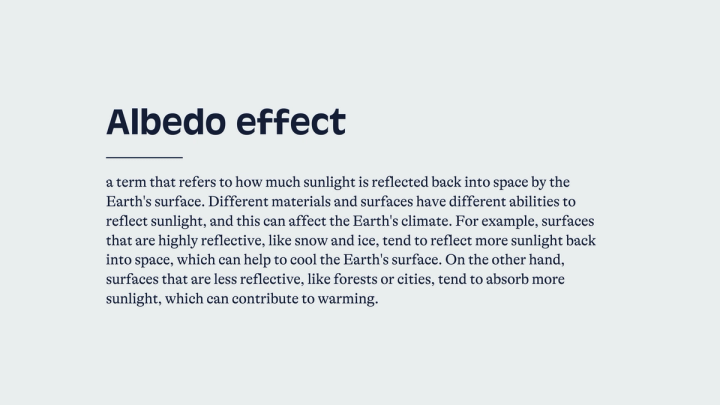
Albedo effect: a term that refers to how much sunlight is reflected back into space by the Earth's surface. Different materials and surfaces have different abilities to reflect sunlight, and this can affect the Earth's climate. For example, surfaces that are highly reflective, like snow and ice, tend to reflect more sunlight back into space, which can help to cool the Earth's surface. On the other hand, surfaces that are less reflective, like forests or cities, tend to absorb more sunlight, which can contribute to warming.
Afforestation: afforestation is the process of introducing trees and tree seedlings to an area that has previously not been forested. Afforestation can be done through tree planting and seeding, naturally or artificially.
Anthropocene: a term used to describe this epoch in which humans have affected, or have had the dominant influence on, the Earth’s climate. Officially, the current epoch that we live in is called the ‘Holocene’, but some have argued that there’s a need for a new term that specifically refers to human activity's effects on our planet.
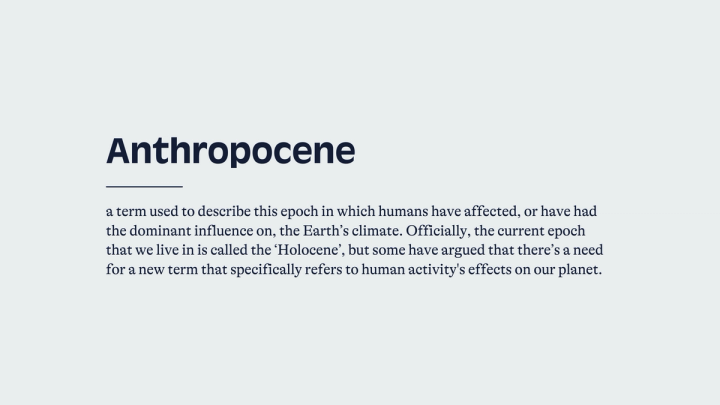
Cap and trade: a common term for a government regulatory program designed to limit, or ‘cap’, the total level of emissions of certain chemicals, particularly carbon dioxide, as a result of industrial activity. An example would be the European Union capping the amount of carbon emissions permitted to an industry, such as aviation or shipping. The EU issues a limited number of annual permits that allow companies to emit a certain amount of carbon dioxide. The total amount of the cap is split into allowances and distributed to companies (either for free or through an auction). Companies can also trade their allowances to other companies that emit (or want to emit) more. Governments usually lower the total ‘cap’ year after year, thereby (ideally) lowering total emissions.
Carbon credits: a form of currency that can be bought and sold to offset carbon dioxide emissions. Each carbon credit represents a reduction of one ton of carbon dioxide in the atmosphere. Companies and governments may purchase carbon credits to offset their own emissions or to support projects that reduce greenhouse gases.
Carbon footprint: a carbon footprint is a measure of the amount of greenhouse gases produced by an individual, organization, or country. It is calculated by taking into account the emissions associated with activities such as transportation, electricity use, and the production of goods and services. Reducing your carbon footprint means taking steps to reduce your greenhouse gas emissions.
Carbon insetting: the practice of reducing greenhouse gas emissions within a company's own operations and supply chain. The goal of carbon insetting is to reduce the carbon footprint of a company and mitigate the impacts of climate change. Carbon insetting is often contrasted with carbon offsetting, which involves supporting projects that reduce greenhouse gas emissions in other areas, such as renewable energy projects or reforestation projects. Read more about how Sustainable Aviation Fuel (SAF) can be an effective carbon insetting tool.
Carbon negative: to be carbon negative refers to individuals, organizations, or events that remove more carbon dioxide from the atmosphere than they emit. This can be achieved through a variety of methods, such as carbon capture and storage or reforestation projects.
Carbon neutral: carbon neutral refers to an individual, organization, or event that has offset its carbon dioxide emissions by taking actions to remove an equivalent amount of carbon dioxide from the atmosphere. This can be achieved through a variety of methods, such as planting trees or investing in renewable energy projects.
Carbon offsetting: the practice of supporting projects that reduce greenhouse gas emissions in order to offset the emissions produced by an individual, organization, or event. Carbon offsetting can be used to mitigate the impacts of climate change by reducing the overall amount of greenhouse gases in the atmosphere. Carbon offsets can be purchased by individuals, organizations, or governments as a way to offset their own emissions or to support the development of clean energy and other climate-friendly projects. It is important to note that while carbon offsetting can be a useful tool for mitigating the impacts of climate change, it should not be used as a substitute for reducing emissions at their source. Learn more about how you can choose the right carbon offset projects for your company.
Climate positive: Climate positive refers to actions or practices that remove more carbon dioxide from the atmosphere than they emit. This can be achieved through a variety of methods, such as carbon capture and storage or reforestation projects.
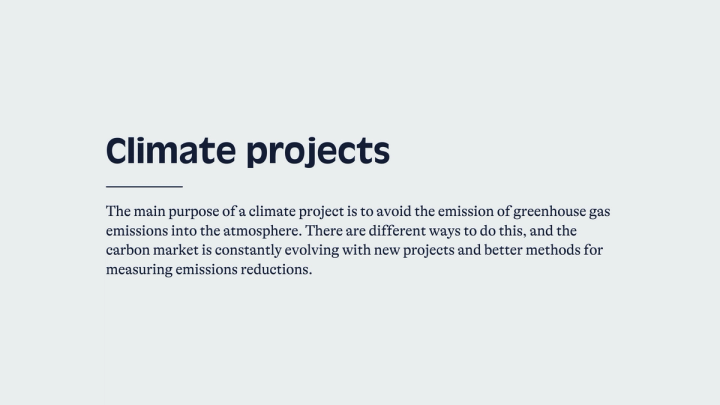
Climate projects: The main purpose of a climate project is to avoid the emission of greenhouse gas emissions into the atmosphere. There are different ways to do this, and the carbon market is constantly evolving with new projects and better methods for measuring emissions reductions. Learn more about how you can address your carbon footprint with climate projects.
CO2e emissions: refers to ‘carbon dioxide and equivalent’, which includes other greenhouse gases (GHG, see below). This measurement is used to compare the impacts of different gases on a common scale, with carbon dioxide as the reference gas.
Community-based solutions: initiatives that involve the participation and engagement of local communities in addressing the impacts of climate change and promoting sustainable practices that mitigate greenhouse gas emissions. They can also provide economic benefits by creating local jobs and contributing to developing a low-carbon economy. Learn more about community-based solutions here.
Compensation: Carbon compensation refers to the practice of offsetting or neutralizing greenhouse gas emissions by investing in projects that remove or reduce an equivalent amount of carbon dioxide (CO2) from the atmosphere. Carbon compensation can be a useful tool for reducing greenhouse gas emissions, but it is not a substitute for reducing emissions at the source and should be used in conjunction with other efforts to reduce and mitigate climate change.
Compliance offset programs: a program where an entity purchases carbon credits to fulfil a regulatory purpose. Mandatory, also referred to as compliance, systems are regulated by national, regional, or provincial laws and mandate carb-intensive emitters to achieve compliance with GHG emission reduction requirements. For regulated emissions sources, offsets can serve as an alternative compliance instrument to direct emissions reductions or allowances (tradable permits allowing a quantity of emissions) that emitters can use to meet their emissions cap. In most cases, compliance programs exist as regional or national cap-and-trade emission trading schemes, such as the European Union Emissions Trading Scheme (EU ETS). Learn more about compliance versus voluntary carbon programs here.
Conference of the Parties (COP): a United Nations body that meets regularly to address issues related to climate change. The COP is made up of representatives from all countries that have signed the United Nations Framework Convention on Climate Change (UNFCCC). At these meetings, countries come together to negotiate agreements and set goals for reducing greenhouse gas emissions and addressing the impacts of climate change.
Corporate social responsibility (CSR): the commitment of companies to operate in an ethical and responsible manner, taking into account the social and environmental impacts of their operations. CSR can include a wide range of activities, such as reducing greenhouse gas emissions, supporting sustainable development, and engaging in philanthropic efforts.

Earthshine: a natural phenomenon that occurs when sunlight is reflected off the Earth's surface and onto the Moon. This can cause the Moon to appear to glow with a faint, diffuse light, even when it is in the shadow of the Earth and not illuminated directly by the Sun.
Ecoanxiety: a term referring to anxiety caused by a dread of environmental perils, especially climate change, and a feeling of helplessness over the potential consequences for those living now and even more so for later generations.
Environmental migrant/refugee: someone who is forced to leave their home region due to sudden or long-term changes to their local or regional environment, such as drought or sea-level rise. For instance, about half of the population of Bangladesh lives less than 5 metres above sea level, and scientists predict that the country will lose 17% of its land by 2050 due to flooding caused by climate change. Morocco, Tunisia, and Libya each lose more than 1,000 km2 each year to desertification, leading people who live at the edge of the Sahara Desert to move to larger cities in North Africa.
Environmental, Social, Governance (ESG) criteria: refers to the three pillars of sustainability: the environment, society, and corporate governance. ESG criteria are used to evaluate the sustainability and social responsibility of companies, and they are increasingly being used by investors as a way to assess the long-term financial performance of companies. Learn more: everything you need to know about ESGs.
ESG reporting: the process of disclosing information about a company's environmental, social, and governance practices. This can include information about a company's greenhouse gas emissions, water usage, employee diversity and inclusion practices, and governance structure. ESG reporting is becoming increasingly important as investors and consumers look for more transparent and sustainable business practices. Free download: getting started with ESG reporting.
Global warming: Global warming refers to the overall warming of the planet due to increased levels of greenhouse gases in the atmosphere. These gases trap heat, causing the Earth's temperature to rise. Human activities such as burning fossil fuels and deforestation contribute to the increased levels of greenhouse gases in the atmosphere, leading to the warming of the planet.
Greenhouse gases (GHG): Any gas that absorbs infrared radiation in the atmosphere and causes a ‘greenhouse’ effect in the atmosphere which in turn leads to global warming. Greenhouse gases include water vapour, carbon dioxide (CO2), methane (CH4), nitrous oxide (N2O), chlorofluorocarbons (CFCs), hydrochlorofluorocarbons (HCFCs), ozone (O3 ), hydrofluorocarbons (HFCs), perfluorocarbons (PFCs), and sulfur hexafluoride (SF6).
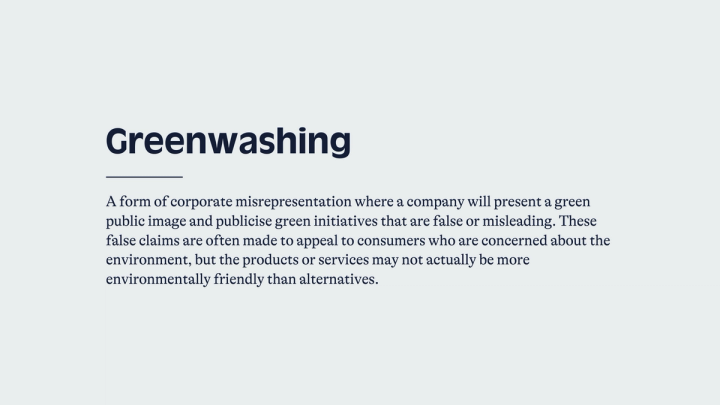
Greenwashing: A form of corporate misrepresentation where a company will present a green public image and publicise green initiatives that are false or misleading. These false claims are often made to appeal to consumers who are concerned about the environment, but the products or services may not actually be more environmentally friendly than alternatives.
Kyoto Protocol: The Kyoto Protocol was an international treaty which extended the 1992 United Nations Framework Convention on Climate Change that commits state parties to reduce greenhouse gas emissions, based on the scientific consensus that global warming is occurring and that human-made CO₂ emissions are driving it.
Mitigation: Any procedure which involves taking actions to reduce greenhouse gas emissions and slow the rate of climate change. This can include transitioning to renewable energy sources, implementing energy efficiency measures, and protecting forests and other natural ecosystems, which absorb carbon dioxide from the atmosphere.
Nature-based solutions: a type of climate project that uses natural processes or ecosystems to address environmental and social challenges. These solutions can include things like protecting and restoring forests and wetlands, which can help to reduce greenhouse gas emissions and improve water quality. Learn more about nature-based solutions here.
Net negative: refers to the goal of removing more carbon dioxide from the atmosphere than is emitted. The goal of net negative is to not only reduce greenhouse gas emissions but to actively remove carbon dioxide from the atmosphere in order to mitigate the impacts of climate change. Net negative is often used in the context of climate policy and refers to the goal of not just reducing emissions, but actively removing carbon dioxide from the atmosphere.
Paris Agreement: The Paris Agreement, often referred to as the Paris Accords or the Paris Climate Accords, is an international treaty on climate change. Adopted in 2015, the agreement covers climate change mitigation, adaptation, and finance.
Reduction: refers to actions taken to reduce the amount of carbon dioxide emitted into the atmosphere. Carbon reduction can be achieved through a variety of methods, including transitioning to renewable energy sources, implementing energy efficiency measures, and protecting forests and other natural ecosystems, which absorb carbon dioxide from the atmosphere. The goal of carbon reduction is to mitigate the impacts of climate change by reducing the amount of greenhouse gases in the atmosphere. Read our carbon reduction guide for climate-conscious companies.
Removals: Carbon removal is the process of removing carbon dioxide from the atmosphere and locking it away for decades, centuries, or millennia, to prevent it from reentering the atmosphere. This can be achieved through a variety of methods, including reforestation, soil carbon sequestration, and carbon capture and storage.
Renewable energy: energy sources which are considered renewable because they are continuously replenished on the earth. Renewable energy can be harnessed through a variety of technologies, including solar panels, wind turbines, and hydroelectric dams. Increasing the use of renewable energy is one way to reduce greenhouse gas emissions and mitigate climate change. Learn more about renewable energy projects here.
Science-based targets (SBT): greenhouse gas emissions reduction targets that are in line with the latest climate science. These targets are used by companies to set goals for reducing emissions and to track progress towards meeting these goals. SBTs are increasingly being adopted by companies as a way to align their business practices with the Paris Agreement's goal of limiting global warming to well below 2°C.
Scope emissions (1, 2, 3): categories of greenhouse gas emissions that are used to measure the carbon footprint of an individual, organization, or country. Scope 1 emissions are direct emissions from a company's own operations, such as burning fossil fuels to generate electricity. Scope 2 emissions are indirect emissions from the consumption of electricity, heat, or steam purchased from other sources. Scope 3 emissions are all other indirect emissions that result from the company's activities, such as the production and transportation of goods and services.
Sustainable Aviation Fuel (SAF): a clean substitute for conventional fossil fuel-based jet fuel. It’s made from sustainably-sourced resources, like agricultural waste. Currently, most SAF in the world is produced from waste oils, fats, and greases. These resources are processed to create a chemical that is almost identical to the kerosene found in jet fuel. As a result, SAF can be safely mixed with existing jet fuel, without requiring a complete overhaul of existing airport infrastructure, engines, or aircraft design. Compared to burning fossil-based jet fuels, the carbon emissions of SAF are up to 80% lower. Read more: how you can support the sustainable aviation fuel revolution.
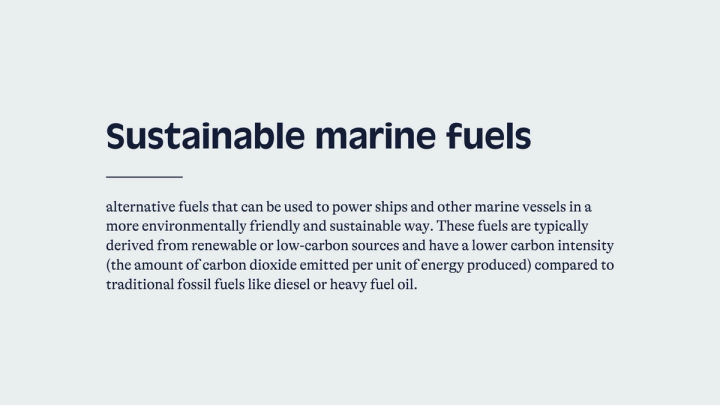
Sustainable marine fuels (also referred to as ‘clean marine fuel’ or ‘sustainable maritime fuel’): alternative fuels that can be used to power ships and other marine vessels in a more environmentally friendly and sustainable way. These fuels are typically derived from renewable or low-carbon sources and have a lower carbon intensity (the amount of carbon dioxide emitted per unit of energy produced) compared to traditional fossil fuels like diesel or heavy fuel oil.
Sustainable Development Goals (SDGs): a set of 17 global goals adopted by the United Nations in 2015 to end poverty, protect the planet, and ensure peace and prosperity for all. The SDGs cover a wide range of issues, including climate change, water and sanitation, and economic growth.
Voluntary carbon markets: a market in which businesses, governments, nonprofit organizations, universities, municipalities, and individuals can offset their emissions outside a regulatory regime. These entities can purchase offsets that were generated either through the voluntary or compliance project-based markets. The voluntary carbon market is distinct from mandatory carbon markets, such as the European Union Emissions Trading System (EU ETS), which are established by governments to regulate and reduce greenhouse gas emissions. In contrast, the voluntary carbon market is driven by the voluntary actions of individuals and organizations that want to reduce their carbon footprint and mitigate their contribution to climate change. Read more: What are voluntary carbon offsets and why should everyone participate?

Zero emissions (also referred to as ‘net zero’ or ‘gross zero’): the goal of achieving net zero greenhouse gas emissions, including both direct and indirect emissions. This means that any emissions that are produced must be offset through activities that remove an equivalent amount of carbon dioxide from the atmosphere. This goal would mean stopping all emissions, which isn’t realistically attainable across all sectors of our lives and industries. Read more about net zero versus carbon neutral.
Understanding these key climate terms is essential for anyone looking to learn more about the impacts of human activities on the environment and what we can do to mitigate these effects. By taking steps to reduce our carbon footprint, we can work towards a more sustainable and healthy planet for all.
-----
About us: CHOOOSE™ is a venture-backed leader in technology-based climate action, building digital tools so that everyone, anywhere, can easily integrate climate action into everyday life and business. Through flexible integrations, customer-friendly interfaces, automated carbon measurement, and a connected marketplace of climate solutions, CHOOOSE delivers a complete platform that enables its partners to build and manage high-impact climate programs. Learn more at www.chooose.today.
POLICIES
PRODUCTS